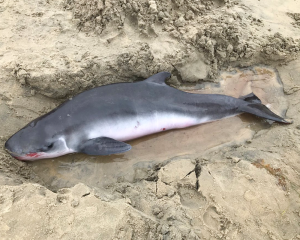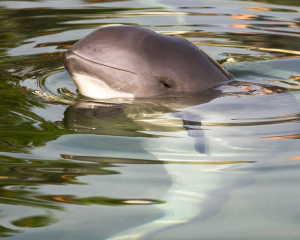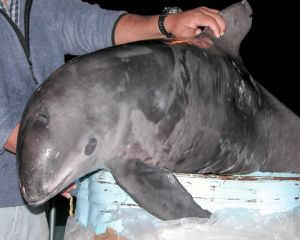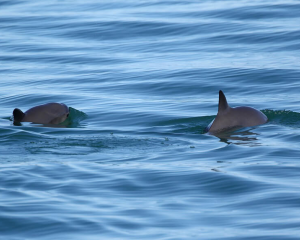
The vaquita (Phocoena sinus) is a small and critically endangered species of porpoise found exclusively in the northern part of the Gulf of California, Mexico. Here are some detailed characteristics and information about the vaquita:
Physical Characteristics
Size: Vaquitas are the smallest porpoise species. They typically measure about 1.2 to 1.5 meters (4 to 5 feet) in length and weigh between 30 to 55 kilograms (66 to 121 pounds).
Appearance: They have a robust body with a rounded head and no distinct beak. Vaquitas are known for their unique facial markings: dark rings around their eyes and dark patches on their lips, giving them a “smiling” appearance. They have a light gray body with a pale or white underside.
Fins and Flippers: Their dorsal fin is tall and triangular, and their flippers are small and rounded, which are typical characteristics of porpoises.

Behavior
Habitat: Vaquitas inhabit shallow, murky waters of the northern Gulf of California, particularly around the Colorado River delta. They prefer waters less than 150 meters (500 feet) deep.
Diet: Vaquitas feed on a variety of small fish and squid. They are thought to hunt by echolocation, similar to other porpoises and dolphins.
Social Structure: Vaquitas are usually solitary or found in small groups of two to three individuals. Unlike some other marine mammals, they are not known for forming large pods.

Conservation Status
Population: The vaquita is critically endangered, with fewer than 10 individuals estimated to remain as of recent assessments. They are the most endangered marine mammal in the world.
Threats: The primary threat to the vaquita is bycatch in illegal gillnets used for fishing another endangered species, the totoaba fish, whose swim bladder is highly valued in traditional Chinese medicine. The nets meant for totoaba often entangle vaquitas, leading to accidental deaths.
Conservation Efforts: Efforts to save the vaquita include banning gillnets in their habitat, establishing protected areas, and increasing surveillance to enforce regulations. International organizations and the Mexican government are actively working to prevent their extinction, but the population continues to decline rapidly.

Importance
The vaquita is often considered a symbol of marine conservation efforts, representing the urgent need to protect marine biodiversity and address human impacts on ocean ecosystems. Their survival is critical for maintaining the ecological balance in the Gulf of California.




